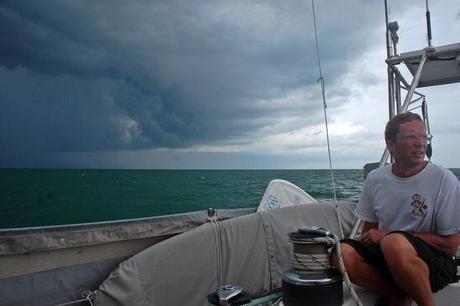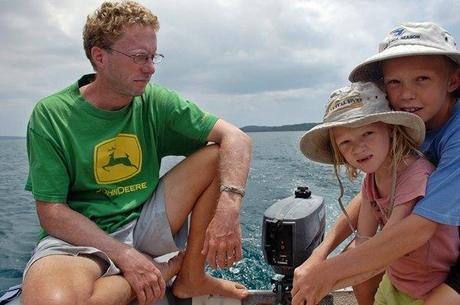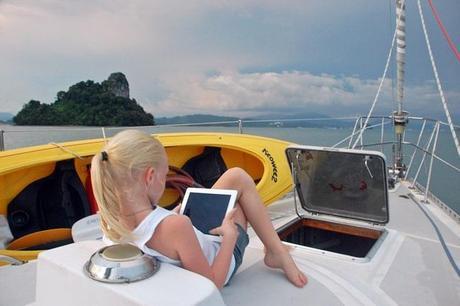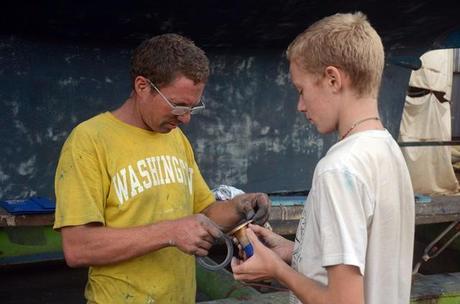
Important pieces of cruising gear aren't always obvious. A reader who hopes to go cruising emailed recently to ask: "When you look back at your years of sailing, what are some pieces of equipment that you brought with you that you never realized how important they would become (e.g. handheld VHF, specific spares, etc.)? "
It's a good question, because it's easy to hemorrhage cash in the run up to taking off for cruising, trying to anticipate the things you might need and eyeing shiny toys in the chandlery. It's impossible to know what's essential because you haven't gone cruising and don't have a style yet. Gearhead? Ascetic? Most of us are somewhere in the middle of the spectrum between those points, and your essential is someone else's throwaway. As much as you can, avoid discretionary purchases some until you have a better sense of what you real needs are.
- Outboard and dinghy you can depend on. Unless you're a marina maven, you're going to rely on it almost every day that you're not passage making- e.g., more than 90% of the time! Don't shortchange yourself. We wouldn't have a dinghy we couldn't plane while loaded, but that's us.
- A spare, small outboard (not important for US/Mexico, because repairs are easy to come by). I thought this was dumb until our Mercury 15 died in Bora Bora. We borrowed a friends small outboard for the rest of the Pacific crossing, because they were way too expensive to buy mid-Pacific. Now we have a Tohatsu 18 and 3.5 (which we just used as the 18 needed a new impeller).
- Excellent ground tackle. There was a servicable primary anchor on Totem, but we replaced it with a beefy Rocna and use 410’ of 3/8" chain. This has served us really well, as have the 50’ of ½” 3 strand nylon snubber ties- use a rolling hitch, and lead fair. We do love this anchor, but any of the scoop type anchors (Mantus, Rocna, Manson, etc) tend to be more reliable over broader bottoms compositions.

- Good cabin fans. If you're spending time in the tropics (and overwhelmingly, cruisers are spending time in the tropics), cabin fans can be a lifesaver for comfort below. After trying a bunch of different brands, we've found the Caframo Ultimate 747s do the best to move more air and are far easier to keep clean (and wow, do fans get dirty when run all day/night!)
- An ereader. Being on a passage without a good book is my nightmare scenario. ereaders hadn't hit the scene when we left to go cruising, so we added many many linear feet of bookshelves to Totem to make sure we never ran out of quality reading. Now, we're happily reclaiming that space and everyone on board has their own: don't think for a minute that you can share one! Tablets are fine, but we like the eink readers best by far: they need much less power, and are far easier to read in daylight.
- VHF. A setup onboard should be obvious, but good handhelds might not be as obvious. They take a lot of use and abuse: we use them to stay in touch on shore as much as ship-to-shore.
- Scanner/printer. We've used this innumerable times to make copies of important documents, from passports to vessel documentation, for clearance in foreign ports.

- Fuel filtering gear. Our Baja filter has been invaluable, and it's priceless to have sufficient fuel filters as well. We always filter diesel and gas putting them in the tank. Despite double filtering, we still we had some dirty fuel issues after a few months in a country where most sources were questionable; having spare filters is a good thing.
- Radar. It's not just fog and ship traffic, it's about invaluable use for piloting in squalls and evaluating chart error by comparing distances.
- LED lights. If your boat isn't LED-centric already, make it so, from running lights to deck an cabin lighting. Power saved is too significant to ingore.
- Good basic tools. Don't pay for high end, because most of them rust just as quickly as the middle range. We've gotten a lot of use from a multimeter an, surprisingly, a VSWR meter.
 Off label bino use: observing a solar eclipse!
Off label bino use: observing a solar eclipse!- Good binoculars. We went a few months without functional binos in an area where eyeball nav is critical, and it was very unpleasant!
- Large storage bags that have a port for sucking out air with vacuum cleaner. It's not just about sealing, but the fact that they are great for reducing the space needed by bulk storage items.
- Spare line. 6mm single braid Dyneema (Amsteel and the like) with a 6mm (1/4”) fid for splicing – very easy to splice and endless uses.
Shopping lists are convenient. Here's the plain truth: YOU are the most valuable equipment of all. Cruising is ALL about attitude! Whether you are newer to sailing or cruising, or have a moderate level experience, we all have to tackle the mental side- regardless of your learning curve.

Go in with an open mind. Learn how to use, and re-use, and get away from the disposable economy of single-use items. Don't try to know everything; ask those around you to help, since cruisers near you may have great experience and are often very generous with their time. On the flip side, cruisers are also full of opinions, so take it all in and then decide for yourself.
Ready yet? The last thing to remember is not to feel like you need to buy everything to reach a perfect state of readiness, because really, there is no such thing. As much as possible, hold off on discretionary purchases until you have a sense of what your real needs are- it's a mental game, not a game of Boat Stuff.
Cruisers in touch with their valuable equipment know we love it when you read this on the Sailfeed website.

